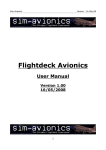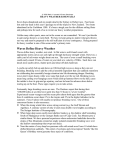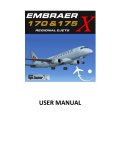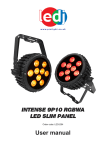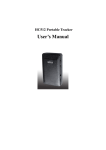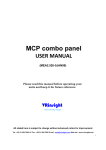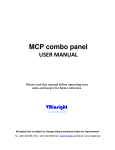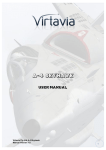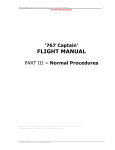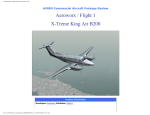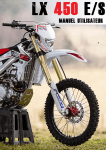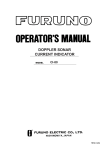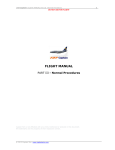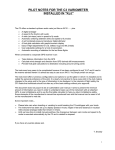Download transavia.com dispatch manager user`s manual Dutch
Transcript
transavia.com virtual OPS FCOM Version 1.0 http://www.transavia-virtual.com/ ©2010, transavia.com virtual airline. Alle rechten voorbehouden. transavia.com virtual dispatch manager handleiding inhoudsopgave inhoudsopgave ................................................................................................... 2 General Information........................................................................................... 4 Preface ........................................................................................................... 4 Maneuver Capability and Flap Usage ............................................................. 4 Flap Operation ............................................................................................... 5 Command Speed ............................................................................................ 5 AFDS usage..................................................................................................... 6 Auto throttle usage ........................................................................................ 6 LNAV and VNAV ............................................................................................. 6 Intentionally left blank ................................................................................... 8 Ground Procedures ............................................................................................ 9 Preface ........................................................................................................... 9 Pre-Flight procedure ...................................................................................... 9 Before Taxi ................................................................................................... 10 Taxi............................................................................................................... 10 Before Take-off ............................................................................................ 11 Takeoff and Initial climb ................................................................................... 12 Preface ......................................................................................................... 12 Takeoff ......................................................................................................... 12 Initial climb................................................................................................... 12 Climb, Cruise and Descent ................................................................................ 13 Climb ............................................................................................................ 13 Cruise ........................................................................................................... 13 Descent ........................................................................................................ 14 Holding ......................................................................................................... 14 2 transavia.com virtual dispatch manager handleiding Approach and missed Approach ....................................................................... 15 Approach...................................................................................................... 15 Missed Approach.......................................................................................... 16 ILS Approach ................................................................................................ 17 Non precision approaches ............................................................................ 18 Circling approach.......................................................................................... 18 Go-around .................................................................................................... 19 Landing ............................................................................................................ 20 Landing flare, touchdown and roll out ......................................................... 20 Speedbrake .................................................................................................. 20 Autobrake policy .......................................................................................... 21 Thrust reverser operation ............................................................................ 21 Crosswind landing ........................................................................................ 21 3 transavia.com virtual dispatch manager handleiding General Information Preface As Transavia.com Virtual Airline is a fictional airline and mainly single pilot operation a new form of Standard Operation Procedures is written. The conventional Boeing 737NG is a crew operated airplane, however the Transavia.com Virtuals fleet contains the single pilot PMDG Boeing 737NG. As every other airline Transavia.com Virtual uses Standard Operating Procedures (SOP) to explain and cope with flight fases and procedures dealed with every flight again. Al normal SOP’s will be done by memory, however callouts are useless as there is no Pilot Monitoring (PM) to keep in the loop. In non-normal conditions a non-normal checklist is presented to the crew to deal with the problems using the Basic Failure Management (BFM) and the read and do Non-normal checklist. Maneuver Capability and Flap Usage Normal flap settings for take-off are flaps 5, flaps 10 and flaps 15, for performance limiting runways. During the initial approach a flap setting of flap 1 and 5 is standard to deal with speed reduction. However situation dependent flaps 10 gear up may be used. Normal landings are made with flaps 30. Use flaps 40 to reduce landing speed and distance or to improve outside view. Takeoff flap retraction speed schedule To retract flaps, airplane must be accelerating (green arrow, speed trend vector) and at/above appropriate flap speed. Note: During acceleration the only save and correct procedure is flap maneuver speed selection prior to flap retraction. Flap extension schedule Select flaps 1 when decelerating and within 10 knots of the flaps-up maneuvering speed (displayed on the airspeed tape as “UP”) after selection set airspeed bug to flaps 1 speed. Repeat this procedure for flaps 5 and flaps 15. Note: during deceleration the only save and correct procedure is flap selection prior to airspeed reduction. 4 transavia.com virtual dispatch manager handleiding Flap Operation The minimum altitude for flap retraction is 1,500 feet H.A.A. Acceleration height – All engines Use 3,000 ft HAA for NADP 1 and use 1,500 ft HAA for NADP 2. When no NADP published or specified use 3,000 ft as standard acceleration height. Acceleration height – Engine Out N-1 after V1 is continuing the SID to provide sufficient obstacle clearance. At 1,500 ft set airspeed bug to flaps up speed and accelerate to clean up. In case of N-1 after V1 on rwy track accelerate above highest MSA rounded off to the nearest 1000 of ft. Command Speed Take off During pre-flight the V2 speed will be set in the MCP for take-off until flap retraction altitude is passed and manually set to flaps up maneuvering speed. Speed can also be altered by the VNAV Pitch mode selection or LVL CHG selection. Climb, Cruise and Descent The command speeds will be set by the FMC using VNAV or manually set on the MCP gained from the FMC. Approach Command speed will be set to maneuvering speed by FMC during VNAV operation or by manual selection on the MCP Landing During the approach with Auto throttle engaged use the Vref Flaps 30 or Vref flaps 40 out of the CDU and add 5 knots to the Vref to gain sufficient protection against wind and gusts. This only applies when Auto throttle is used for landing, Autoland. Using no auto throttle or when it is planned to disengage the auto throttle prior to landing use Vref + half the wind factor plus the full gust factor above steady wind with a maximum of Vref+20 kts. Minimum Command speed selected on 5 transavia.com virtual dispatch manager handleiding the MCP with no auto throttle engaged is Vref+5. However no wind correction is applied for tailwind landings. AFDS usage Autopilot and Flight Director System is a very complicated system in the real B737NG. The engagement of the Autopilot is only possible and should be attempted when flying in trim, no control forces are applied and flown within flight director. However the PMDG does not have this type of demands and can be selected at any time. In order to make the operation as real as it gets try to fly it as the real B737NG. Auto throttle usage During take-off and climb the use of auto throttle is recommended for either manual or automatic flight. During all other flight fases it is recommended to use the auto throttle only when autopilot is engaged. LNAV and VNAV The Boeing 737 has the luxury to control either roll and pitch modes from data received from the FMC displayed in the CDU. However in order to have complete and accurate Lateral Navigation the LEGS page of the FMC must be programmed in order to receive the requested roll mode by the LNAV setting. Therefore it is mandatory to check the entire routing in the LEGS page for discontinuity’s or incorrect waypoints. To gain better understanding it is recommended to use the PLAN mode displayed on the Navigation Display using the EFIS control switch to select PLAN. VNAV is a pitch mode that can be used for various purposes. Mainly it is to used to bring the aircraft from take-off to cruise, and from cruise to the approach. In the meanwhile it can comply with speed and altitude restrictions during SID’s and uses the Cost Index setting from the FMC to control pitch mode and auto throttle modes. However several other settings besides inputs in the FMC must be made. The MCP altitude setting must correspond to the requested level for cruise or approach. All other crossing altitudes laying in between will be calculated and executed by the LNAV mode with information out of the FMC. In case of not able to comply to the restraints set in the FMC 6 transavia.com virtual dispatch manager handleiding the crew will be alerted via the FMC and via an amber light beneath the glareshield but in full view of the pilot with FMC first to attract attention to the CDU of the FMC. 7 transavia.com virtual dispatch manager handleiding Intentionally left blank 8 transavia.com virtual dispatch manager handleiding Ground Procedures Preface In real life operation the cockpit is divided in so called areas of responsibility. The captain and First Officer have their own area of responsibility and a joint area. In the philosophy of flying the B737 of PMDG within the VA it can be said we have one area of responsibility. Therefore I will explain the setting for the captain’s side only for multiple placed features such as ND and PFD. Furthermore al ground operations until Take-Off will be discussed. Pre-Flight procedure EFIS control panel MINIMUMS reference selector FPV METERS BAROMETRIC reference selector VOR/ADF Mode selector CENTER switch Range selector MAP switches FLIGHT INSTRUMENTS CLOCK LIGHT CONTROLS LOGO lights POSITION lights AUDIO CONTROL PANEL MODE CONTROL PANEL (MCP) COURSE FLIGHT DIRECTOR switch (FD) AUTOTHROTTLE switch (A/T) IAS/MACH HEADING check BARO NA NA QNH/QFE SET MAP as desired as desired as desired check SET as desired as desired as desired SET SET SET ON (ma light illuminates) ARM V2 speed from FMC RWY HDG 9 transavia.com virtual dispatch manager handleiding BANK ANGLE LIMIT ALTITUDE chart AUTOPILOTS (CMD A, CMD B) AUTO BRAKE AUTO BRAKE DISARM light VHF NAVIGATION radios ADF radio 25 degrees SID clearance limit as cleared by ATC or by Disengaged Rejected Take-Off (RTO) Extinguished SET for departure SET Before Taxi After completion of the pushback and engine starting the procedure before taxi can start. Consider use of Anti-Ice during take-off. Set Engine start switches CONT. Set the correct flap setting for take-off and check green light illuminated at the flap indicator gauge. Set the stabilizer trim for take-off. Check full deflection and controllability of the flight controls and finally press the RECALL button to confirm no system is malfunctioning as we have used several systems now to configure for take-off. When all items are completed and performed by memory: “BEFORE TAXI CHECKLIST”. After obtaining taxi clearance from ATC check either left and right side clear for other traffic or ground movement. When ready to taxi select taxi and runway turnoff lights on. Taxi Using a large airplane such as the B737 with a great wingspan on the apron is a large responsibility to keep adequate control and maintain it on the yellow line. Make sure no disturbance is made by making last minute selections. This can be postponed to a time the plane is not moving. In order to start moving a thrust selection of 35% N1 could be necessary, check left or right if the plane is starting to move and start reducing thrust to taxi almost at IDLE thrust. Use slow taxi speeds at aprons as there is a large amount of obstacles present, 15kts is maximum. The normal taxi speed is 20kts and 10 transavia.com virtual dispatch manager handleiding 30kts on long straight taxiways. Try to use appropriate speed during turns, a speed of 10 kts is advisable. Do not “ride the brakes”, when the plane accelerates on IDLE thrust, brake to approximately 5 to 10 kts to reduce tire wear and overheating the brakes and let the plane accelerate again and repeat the procedure. Differential braking and braking in turns is to be avoided. Before Take-off When approaching the departure runway inform ATC and when is available execute the “BEFORE TAKE-OFF CHECKLIST”. When cleared to line-up check MCP to correspond to any last minute changes, set Transponder to TA/RA and bring Strobe lights on. 11 transavia.com virtual dispatch manager handleiding Takeoff and Initial climb Preface The takeoff is one of the most critical fases of the flight as speed is very high and thrust is near its max. It is always preferable to conduct the rolling departure as it reduces the risk of damage from a foreign object without reducing take-off performance. A drive to try and meet perfection on the takeoff procedure may prevent accidents to occur under the above mentioned circumstances. Takeoff When takeoff clearance is received select Landing light on and taxi light off. This to indicate all other traffic that the plane on the runway is commencing the Take-off. Make sure the airplane is aligned on the runway centerline before setting initial thrust. The take-off procedure the starts as follows: Advance thrust levers to a minimum of 40% N1 Make sure symmetrical initial thrust is selected and stabilized Push TOGA button and start timer Ensure thrust is advancing to N1 limit and A/T, FMA indicates “N1” Check speed during 80kts call Verify that A/T, FMA indicates “THR HOLD” passing 84 kts At call “V1” release throttles and keep both hands on the yoke At call “Rotate” initiate a smooth rotation of 2-3 degrees per second to initial 15 degrees As soon as established follow the pitch bar of the F/D Positive rate, select the gear up This completes the segments of the Take-off and continues with the initial climb. Initial climb As soon as the climb is stabilized from transition out of the Take-off select LNAV when passing 400ft AGL. If such navigation is not possible for the time being. I.e. ATC clearance, rwy track or the SID does not start from the runway 12 transavia.com virtual dispatch manager handleiding end we can select another ROLL MODE. HDG SEL is a proper roll mode to initiate a roll mode. When in trim and flying in the Flight Director the company’s B737NG is certified to initiate the Autopilot passing 400ft AGL. At this moment we have either, Pitch mode (TO/GA), Roll mode (LNAV or HDG SEL) and Thrust mode (THR HOLD/N1). After passing 1500 ft AGL the auto throttle reduces thrust to climb thrust, CLB will be displayed above the N1 indicators. There are several destinations the company uses where Noise Abatement Departure Procedures (NDAP) applies. Two different NDAP’s are available and is defined by airport. Passing the respectively NDAP heights we set the speed bug to the Flaps up speed maneuvering speed. The corresponding speed is indicated on the speed tape in green, indicating UP. When accelerating to the flaps up speed, select the corresponding flap setting when passing the maneuvering speed of the setting indicated on the speedtape until flaps up. This completes the initial climb. Climb, Cruise and Descent Climb After flap retraction select VNAV to ensure that FMC complies with speed/altitude restrictions. The FMC will now take over the Thrust mode and FMA changes from THR HLD/N1 in to FMC SPD. The speed selection that the FMC will make is displayed on the CDU on the CLB page. This will normally result in 250kts below FL100 and an economical speed above FL100. In case of no FMC available, training sessions or other conditions which does not uses the FMC select 280kts above FL100. Cruise When leveled off at the desired/cleared FL the FMC provides speed. LNAV provides roll mode and the VNAV is taking care of the pitch mode. At this time it is possible to manage the plane by heart . 13 transavia.com virtual dispatch manager handleiding Descent When completely programmed the FMC for speed/STAR and approach the Top of descent is calculated and displayed on the MAP mode as T/C. Exact data can be found at the DES page of the CDU. In case of no FMC available, training sessions or other conditions which does not uses the FMC select 280kts above FL100 and 250kts below FL100 Holding In case of joining the hold reduce to holding speed displayed in the HOLD page. Make sure that the holding speed displayed does not exceeds the published holding speed. If so consider flaps 1 combined with flaps 1 maneuvering speed. Prior joining the hold make sure how to enter the hold and with which speed. 14 transavia.com virtual dispatch manager handleiding Approach and missed Approach Approach A correct approach is a stabilized approach which means, on speed in landing configuration (Gear down Flaps 30) with N1 up to approach setting and landing checklist completed by: IMC precision 1000ft AAL VMC Precision 500ft AAL Visual Approach 500ft AAL When the plane is not stabilized a Go-Around must be initiated. Several setting has to be made to configure the plane for the approach. It is advisable to do so during cruise when time is available. Check pressurization to set LDG alt. Review the charts for the approach and start selecting items on the EFIS panel and the MCP. First of all set the DA(H) or MDA(H) depending on type of approach. Set the Inbound CRS selectors and arm the required AUTOBRAKE setting. Make sure that NAVAIDS are selected on the pedestal As we are flying single pilot operation a briefing is not required. However to create situational awareness it is advisable to read the charts thoroughly. When crossing the runways threshold the plane should be: Stabilized on the flight path, correcting it with normal maneuvering Be positioned to land the aircraft in the touchdown zone Stabilized on the Vref speed The go-around must be initiated when the above criteria cannot be maintained. 15 transavia.com virtual dispatch manager handleiding Missed Approach When flying on any instrument approach and in IMC conditions and the below stated items occurred: When flight instruments failures occur, navigation radios fail which are aids to complete the approach When full deflection of ILS GS or Localizer occurs When on radar approach; PAR of SRE and a comm. Failure occurs 16 transavia.com virtual dispatch manager handleiding ILS Approach The ILS approach is the most accurate approaches of any kind . Therefore it is called the precision approach. Most of the times radar vectors will be given to guide the plane to the localizer. The speed used to intercept the Localizer is flaps 5 maneuvering speed, presented on the PFD speed tape in green indicating 5. Obviously a flap setting of 5 is used. The ILS is intercepted with APP mode of the AFDS. Once intercepting the LOC the FMA of the ROLL mode will change from HDG to LOC. Make sure to be established on the LOC with flaps 5 and corresponding speed. And select runway HDG. At the moment that GS starts moving once at minimum approach altitude e.g. 2000ft @ EHAM, the following procedure must be made to ensure correct configuration: “GS Alive”-“Gear down, flaps 15”-“Flaps 15 maneuvering speed set”-“start switches continues”-“speedbrake armed (check annunciation)” At the time GS is captured by checking the FMA changing from ALT HLD to GS select flaps 30 and corresponding Final Approach Speed (FAS) which means Vref+5 of Vref+wind correction. Once established on the GS set missed approach altitude in MCP window. Execute “Landing checklist” Check altitude VS distance at the FAF or OM, see approach plate. When executing an Autoland make no wind corrections to the Vref and check at 1500ft Radio altitude the 2nd Autopilot is engaged by checking the FLARE annunciation indicating. Check continuously GS vs LOC when flying manual or Automatic. When executing the autoland, make sure to disengage both autopilots and take over manual control, when crosswind conditions occur manual rudder input must be given to de-crab the aircraft and line-up with the centerline. Make sure not to disengage the Autobrakes when de-crabbing the plane. 2 seconds after touchdown the A/T will be disengaged and sufficient reverse thrust must be initiated. 17 transavia.com virtual dispatch manager handleiding Non precision approaches The non precision is not that very different from the ILS approach, it is also a normal glidepath however as the name indicates. It is not very precise. The lateral part of the approach can be a NDB or a VOR. The vertical part of the approach must be made using v/s. As a rule of thumb the v/s that must be used is approx. 5times the GS + 50ft. E.g. 140kt GS, the v/s must be 140*5=700+50=750ft a minute. When passing the check altitudes slight adjustments can be made out of the 750ft a minute. When intercepting the approach select VOR/LOC or adjust HDG for a NDBapproach. Set MDA on MCP when FMA ALT HLD is annunciated. Once established, set rwy heading. As the ILS approach we intercept with flaps 5 and corresponding speed. As we have no GS to indicate when to select gear and flaps we use the following procedure: 2nm for FAF “Gear down, flaps 15”-“Flaps 15 maneuvering speed set”-“start switches continues”-“speedbrake armed (check annunciation)” 1nm for FAF “Flaps 30 set Vref speed” 0.2 nm for FAF “v/s xxx ft/min” execute landing checklist. Make sure to check altitude vs distance. Once approaching the MDA set the MCP to missed approach altitude. Circling approach During operation when the approach runway experiences tailwind but is the only runway with an instrument approach a circling approach can be made. Check plates for the MDA or circling height. When braking off the approach to join downwind report ATC braking off (left or right) by a 45 degrees angle of the runway centerline. During the approach fly flaps 5 and flaps 5 speed. Once braking off level off at required altitude or 1500ft altitude. Maintain a parallel track of the landing runway. When turning base or initiating the turn to base extend landing gear, select flaps 15 with corresponding speed, arm the speedbrake and set start switches continues. Reduce thrust and descent 600-700 ft/min. Before entering the turn to final extend landing flaps and reduce to Vref speed + correction. 18 transavia.com virtual dispatch manager handleiding Go-around If visual reference is lost the runway obstructed or any other circumstance that requires a Go-around immediate action must be made to clear the approach or obstacles. It has to be clear that every approach ends up in a go-around unless the opportunity is there to make a landing. So make sure that runway heading is set during approach and the missed approach altitude set on the MCP prior to reaching the MDA(H) or DA(H) and review the missed approach procedure. When the go-around has to be initiated the following procedure has to be made: “Go-around, flaps 15, set Go-around thrust” (check the go-around thrust after pushing the TO/GA button) “Gear up” when positive rate, once above 400ft AGL press “HDG select” on the MCP. “Tune navaids for missed approach” When reaching missed approach altitude “set flaps up speed”. When passing 3000ft press “LVL change, set flaps up speed”. Retract flaps on schedule and maintain minimum clean speed. When time permits inform ATC in between all actions. When no time available inform ATC as stated in missed approach procedure . “After take-off checklist” 19 transavia.com virtual dispatch manager handleiding Landing Landing flare, touchdown and roll out Begin with a stabilized approach on speed, in trim and on glide path. When threshold passes under the airplanes nose and out of sight, shift the visual sighting point to approx ¾ down the runway. Maintain constant speed and descent rate. Initiate the flare when the main gear is approx 15 ft above the runway by increasing pitch attitude by approx 2 to 3 degrees. This will slow rate of descent. As the flare is initiated , smoothly retard the thrust levers to idle and make small pitch attitude adjustments to maintain the desired descent rate to the runway. Ideally, main gear makes touchdown when simultaneously thrust levers are reaching idle. At touchdown a pitch attitude is 4 to 6 degrees with an airspeed of Vref plus any gust correction. Do not trim the stabilizer during flare or after touchdown. Gently reduce thrust when initiating the flare to compensate the nose down moment of thrust reduction by give an nose up input on the yoke. Do not attempt to extend the flare by increasing pitch attitude in an attempt to achieve a perfectly smooth touchdown. Do not attempt to hold the nose wheel off the runway. Speedbrake The speedbrakes are used to brake the speed of the aircraft and are, once armed, extended by having weight on wheels. Monitor if speedbrakes are extended upon landing. When not deployed automatically extend without delay manually. 20 transavia.com virtual dispatch manager handleiding Autobrake policy For Take-off: RTO For landing: standard setting is 1, Normal procedures will be to use manual brake below 100kts to minimize brake wear and reduce cooling time. For landing: Autobrake 2 or 3, used for short, wet or slippery runways For landing: Autobrake MAX, When minimum stopping distance is required. Thrust reverser operation After touchdown without any delay select reverse thrust as desired as the reverse mode only redirects the flow, so it can be understood that when engine reached full idle thrust it has to be spooled up again. Pull the reverse lever in the first detent causing the doors to open, a slight delay is created in order to open the doors, once opened the reverse levers can be pulled into the second detent. When necessary in an event of an RTO the levers can be pulled in a third detent causing max reverse thrust but in normal operation limit to the 2nd detent. When reaching 60 knots reduce to idle thrust until reaching taxispeed and cancel the reverse. Crosswind landing In order to maintain runway track in crosswind conditions a wind correction angle has to be made to maintain desired track. To delete the angle prior to landing downwind rudder has to be applied to achieve the nose to be aligned with the runway centerline. To counterwork the upcoming effect of the upwind wing due to sweep effect. Counterwork this with aileron to maintain wings level during touchdown. 21





















